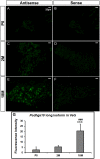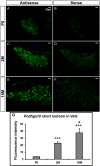Identification of a genetic variant underlying familial cases of recurrent benign paroxysmal positional vertigo
- PMID: 33956893
- PMCID: PMC8101739
- DOI: 10.1371/journal.pone.0251386
Identification of a genetic variant underlying familial cases of recurrent benign paroxysmal positional vertigo
Abstract
Benign paroxysmal positional vertigo (BPPV) is the most common cause of vertigo in humans, yet the molecular etiology is currently unknown. Evidence suggests that genetic factors may play an important role in some cases of idiopathic BPPV, particularly in familial cases, but the responsible genetic variants have not been identified. In this study, we performed whole exome sequencing [including untranslated regions (UTRs)] of 12 families and Sanger sequencing of additional 30 families with recurrent BPPV in Caucasians from the United States (US) Midwest region, to identify the genetic variants responsible for heightened susceptibility to BPPV. Fifty non-BPPV families were included as controls. In silico and experimental analyses of candidate variants show that an insertion variant rs113784532 (frameshift causing truncation) in the neural cadherin gene PCDHGA10 (protocadherin-gamma A10) is an exceedingly strong candidate (p = 1.80x10-4 vs. sample controls; p = 5.85x10-19 vs. ExAC data; p = 4.9x10-3 vs. NHLBI exome data). The mutant protein forms large aggregates in BPPV samples even at young ages, and affected subjects carrying this variant have an earlier onset of the condition than those without [average 44.0±14.0 (n = 16) versus 54.4±16.1 (n = 36) years old, p = 0.054]. In both human and mouse inner ear tissues, PCDHGA10 is expressed in ganglia, hair cells and vestibular transitional epithelia. Fluorescent RNA in situ hybridization using mouse inner ear tissues shows that expression increases with age. In summary, our data show that a variant in the PCDHGA10 gene may be involved in causing or aggravating some familial cases of recurrent idiopathic BPPV.
Conflict of interest statement
The authors declare no conflict of interest.
Figures






Similar articles
-
A novel genetic variant associated with benign paroxysmal positional vertigo within the LOXL1.Mol Genet Genomic Med. 2020 Oct;8(10):e1469. doi: 10.1002/mgg3.1469. Epub 2020 Aug 22. Mol Genet Genomic Med. 2020. PMID: 32827243 Free PMC article.
-
Downregulation of VDR in benign paroxysmal positional vertigo patients inhibits otolith‑associated protein expression levels.Mol Med Rep. 2021 Aug;24(2):591. doi: 10.3892/mmr.2021.12230. Epub 2021 Jun 24. Mol Med Rep. 2021. PMID: 34165161
-
Association of benign paroxysmal positional vertigo with vitamin D deficiency: a systematic review and meta-analysis.Eur Arch Otorhinolaryngol. 2018 Nov;275(11):2705-2711. doi: 10.1007/s00405-018-5146-6. Epub 2018 Oct 9. Eur Arch Otorhinolaryngol. 2018. PMID: 30302575
-
A familial form of benign paroxysmal positional vertigo maps to chromosome 15.Int J Neurosci. 2015;125(8):593-6. doi: 10.3109/00207454.2014.953157. Epub 2014 Sep 12. Int J Neurosci. 2015. PMID: 25135283
-
Clinical significance of cervical and ocular vestibular evoked myogenic potentials in benign paroxysmal positional vertigo: a meta-analysis.Eur Arch Otorhinolaryngol. 2019 Dec;276(12):3257-3265. doi: 10.1007/s00405-019-05674-4. Epub 2019 Oct 11. Eur Arch Otorhinolaryngol. 2019. PMID: 31605189 Review.
Cited by
-
Association of Tinnitus with Benign Paroxysmal Positional Vertigo.J Clin Med. 2025 Apr 4;14(7):2473. doi: 10.3390/jcm14072473. J Clin Med. 2025. PMID: 40217922 Free PMC article.
-
Transcriptomic analysis reveals cross-talk genes between type 2 diabetes and recurrent benign paroxysmal positional vertigo.Heliyon. 2024 Jul 29;10(15):e35209. doi: 10.1016/j.heliyon.2024.e35209. eCollection 2024 Aug 15. Heliyon. 2024. PMID: 39170394 Free PMC article.
-
Prevalence of Symptoms Suggestive of Benign Paroxysmal Positional Vertigo and Associated Factors Among Adults Attending King Saud Medical City in Riyadh.Cureus. 2025 Jul 15;17(7):e87976. doi: 10.7759/cureus.87976. eCollection 2025 Jul. Cureus. 2025. PMID: 40821208 Free PMC article.
-
PCDHGA10 as a Potential Biomarker of Lung Squamous Cell Carcinoma Based on Bioinformatics and Experimental Verification.Mol Biotechnol. 2025 May;67(5):2002-2022. doi: 10.1007/s12033-024-01178-7. Epub 2024 May 10. Mol Biotechnol. 2025. PMID: 38727881
References
-
- Bloom J, Katsarkas A. Paroxysmal positional vertigo in the elderly. J Otolaryngol. 1989;18(3):96–8. - PubMed
Publication types
MeSH terms
Substances
Grants and funding
LinkOut - more resources
Full Text Sources
Other Literature Sources
Medical
Molecular Biology Databases
Research Materials

